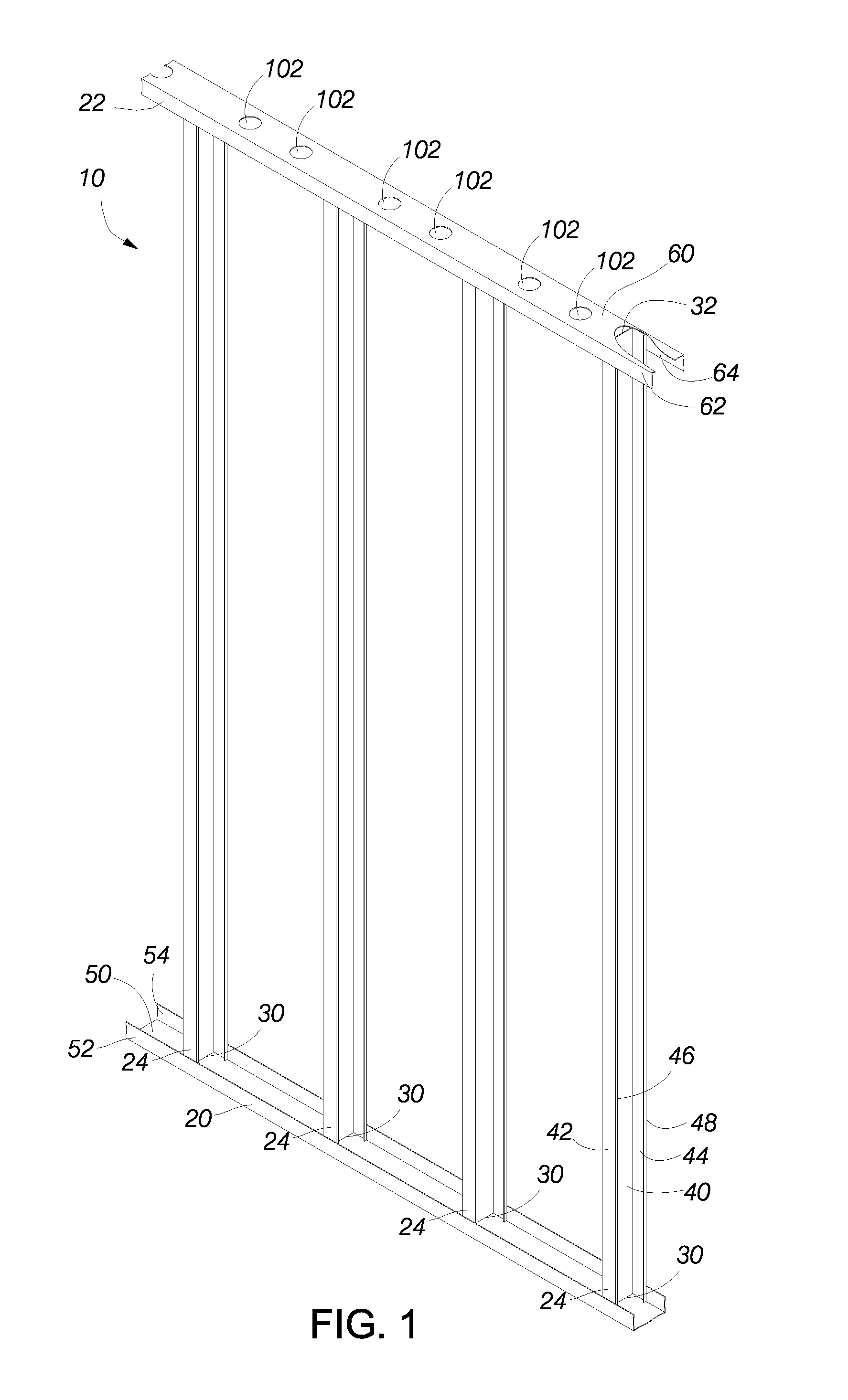[0008] In certain embodiments, the
granular material comprises a stony material. For example, the stony material comprises sand in certain embodiments. In certain embodiments, a flexible sheet (e.g., a
rubber sheet) is suspended from the upper support member in a position between the first panel and the second panel. The flexible sheet has a first face and a second face. A first portion of the granular filler material is positioned between the first face of the flexible sheet and the first panel, and a second portion of the granular filler material is positioned between the second face of the flexible sheet and the second panel. In particular embodiments, a sheet of woven para-
aramid fiber (e.g.,
Kevlar®) is loosely coupled to at least one of the first face and the second face. For example, the woven sheet is secured to the flexible sheet at a plurality of spaced apart locations. In certain embodiments of the wall
system, a self-sealing material is positioned on the inside of the metallic sheet to inhibit loss of the granular filler material when the metallic sheet is penetrated by a
projectile.
[0010] In certain embodiments of the method, the
granular material comprises a stony material, such as, for example, sand. In certain embodiments, the method further comprises suspending a flexible sheet (e.g., a
rubber sheet) from the upper horizontal member. The flexible sheet extends from the upper horizontal member to a position
proximate the lower horizontal member. In certain embodiments of the method, the flexible sheet is suspended from the upper horizontal member prior to filling the cavity with the granular filler material. In accordance with one embodiment of the method, the flexible sheet is mounted with a first portion of the granular filler material between the flexible sheet and the first panel and with a second portion of the granular filler material between the flexible sheet and the second panel. In accordance with another embodiment of the method, the first portion of granular filler material has a first volume and the second portion of granular filler material has a second volume. In accordance with one embodiment of this aspect of the method, the first volume and the second volume are substantially equal. In certain embodiments of the method, the flexible sheet has a first face and a second face, and a sheet of woven para-
aramid fiber (e.g.,
Kevlar®) is mounted to at least one of the first face or the second face. In certain embodiments, the sheet of woven Kevlar fibers is fastened to the flexible sheet at a plurality of spaced apart locations to provide a
loose coupling between the flexible sheet and the Kevlar sheet. In certain embodiments of the method, a self-sealing material is positioned on the inside of the sheet of
metal to inhibit loss of the granular filler material when the metallic sheet is penetrated by a
projectile.
[0011] Another aspect of an embodiment disclosed herein is a method of constructing a protective wall
system. The method comprises erecting a plurality of vertical support members between a lower horizontal member and an upper horizontal member to form a wall frame having a first side and a second side. The method further comprises mounting a first panel on a first side of the wall frame and mounting a second panel on a second side of the wall frame to form a cavity therebetween. At least one of the first panel and the second panel comprises a sheet of construction material and a sheet of metal adhered to the sheet of construction material. The method further comprises filing the cavity with a granular filler material. Certain embodiments of the method include suspending a flexible sheet (e.g., a
rubber sheet) within the cavity. Certain embodiments further include loosely mounting a sheet of woven para-aramid fiber (e.g., Kevlar®) to at least one side of the flexible sheet. In certain embodiments of the method, a self-sealing material is positioned on the inside of the sheet of metal to inhibit loss of the granular filler material when the metallic sheet is penetrated by a
projectile.
[0013] In certain embodiments of the wall section, the granular material comprises a stony material, such as, for example, sand. In certain embodiments of the wall section including a flexible sheet, the flexible sheet is in a plane between and generally parallel to the first panel and the second panel. The flexible sheet has a first face and a second face. A first portion of the granular filler material is positioned between the first face of the flexible sheet and the first panel, and a second portion of the granular filler material is positioned between the second face of the flexible sheet and the second panel. In certain embodiments, the wall
system further comprises a sheet of woven para-aramid fiber (e.g., Kevlar®) loosely coupled to at least one of the first face and the second face of the flexible sheet. For example, the woven sheet of Kevlar fiber is secured to the flexible sheet at a plurality of spaced apart locations. In certain embodiments of the wall section, a self-sealing material is positioned on the inside of the sheet of metal to inhibit loss of the granular filler material when the metallic sheet is penetrated by a projectile.
 Login to View More
Login to View More 


